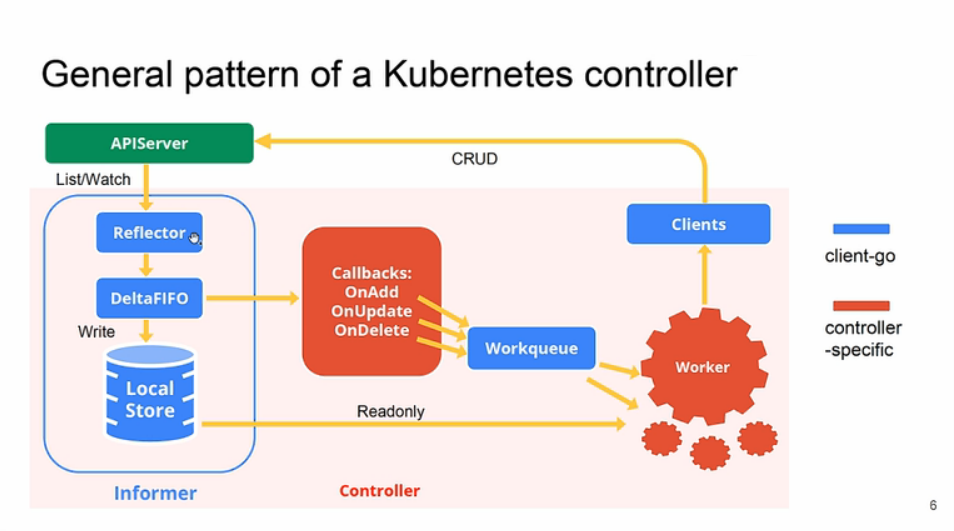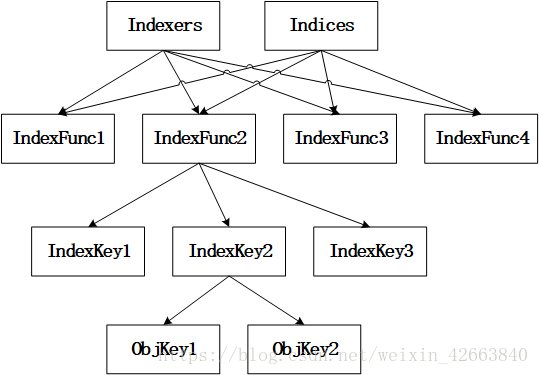indexer
Indexer¶
Indexer是Informer中一部分,Informer在 client-go 中是非常重要的部分,但是由于 Informer 内容比较庞大,我们这里先介绍 Indexer,从字面上看是索引器的意思,他所在的位置就是 Informer 的LocalStore,其实 Indexer 就是存储。
和数据库类似索引和存储是息息相关的,索引构建在存储之上,可以让我们按照某些条件查询数据的时候会很快。
在了解
Indexer之前我们需要先看几个重要的类型来了解 Indexer 是如何实现索引的:
// client-go/tools/cache/index.go
// IndexFun 知道如何为对象提供索引值,说白了就是计算对象的索引,传入对象,输出字符串索引数组
type IndexFunc func(obj interface{}) ([]string, error)
type Index map[string]sets.String // 每种计算索引的方式会输出多个索引(数组),而多个目标可能会算出相同索引
// 索引键 -> 对象键set集合
// Indexers 映射一个名字到一个 IndexFunc
type Indexers map[string]IndexFunc // 计算索引的函数有很多,用名字来进行分类,就是索引分类
// 分类1(特征1) -> 获取对象的索引键(数组)
// Indices 映射一个名字到一个Index
type Indices map[string]Index // 由于有多种计算索引的方式,那就又要按照计算索引的方式组织索引
// 分类1(特征1) -> 所有索引
Indexers:分类1 -> IndexFunc([indexKey1,indexKey2....]) Indices: 分类1 -> Index indexKey1 -> [objKey1, objKey2...] indexKey2 -> [objKey3, objKey4...]
上面几种类型理解起来有点费劲,命名看上去也差不多。索引的目的就是为了快速查找,这个是毋庸置疑的,比如我们需要查找某个节点上的所有 Pod,那就要 Pod 按照节点名称排序,对应上面的 Index 类型就是 map[nodename]sets.podname,但是我们可能有很多种查找方式,这就是 Indexers 这个类型的作用了。
Indexers和Indices都是按照 IndexFunc 分组,每个 IndexFunc 输出多个 IndexKey,产生相同 IndexKey 的多个对象存储在一个集合中。为了明确意义,我们这里先统一几个概念:
- IndexFunc1...这些都是索引函数的名称,我们称之为索引类,大概意思就是把索引分类了
- IndexKey1...这些是同一个对象在同一个索引类中的多个索引键值,我们称之为索引键
- ObjKey1...这些是对象键,每个对象都有唯一的名称
现在我们再来查看
Indexer与索引相关的接口定义:
// client-go/tools/cache/index.go
// Indexer 是一个存储接口,可以让我们使用多个索引函数来获取对象列表
type Indexer interface {
Store // 继承了 Storge 这个接口(client-go/tools/cache/store.go)
// indexName 索引类,obj 是对象,计算 obj 在 indexName 索引类中的索引键
// 通过索引键把所有对象取出来,基本就是获取符合 obj 特征的所有对象,所谓的特征就是对象在索引类中的索引键
Index(indexName string, obj interface{}) ([]interface{}, error)
// indexKey 是 indexName 索引类中的一个索引键,函数返回 indexKey 指定的所有对象键
// 这个对象键是 Indexer 内唯一的,在添加的时候会技术
IndexKeys(indexName, indexKey string) ([]string, error)
// 获取 indexName 索引类中的所有索引键
ListIndexFuncValues(indexName string) []string
// 与 Index 函数类似,只是返回值不是对象键了,而是所有对象
ByIndex(indexName, indexKey string) ([]interface{}, error)
// 返回 Indexers
GetIndexers() Indexers
// 添加 Indexers 到存储(store)中,即添加索引分类
AddIndexers(newIndexers Indexers) error
}
上面是
Indexer这个接口的定义,其中继承了Store这个接口,我们再来看看该接口的定义:
// client-go/tools/cache/store.go
type Store interface {
// 添加对象
Add(obj interface{}) error
// 更新对象
Update(obj interface{}) error
// 删除对象
Delete(obj interface{}) error
// 列举对象
List() []interface{}
// 列举对象键
ListKeys() []string
// 获取 obj 相同对象键的对象,对象键是通过对象计算出来的字符串
Get(obj interface{}) (item interface{}, exists bool, err error)
// 通过对象键直接获取对象
GetByKey(key string) (item interface{}, exists bool, err error)
// 用 []interface{} 替换 Store 存储的所有对象,相当于会删除存储中原有的所有内容,然后再添加新的对象
Replace([]interface{}, string) error
// 重新同步
Resync() error
}
从上面接口中我们可以看出每个对象都要有唯一的键,键的计算方式就要依赖具体的实现了。接下来我们就来看看
Indexer的具体实现。
cache¶
cache是Indexer中非常经典的一种实现,所有的对象缓存在内存中,从名称来看可以知道是属于包内私有的内型,外部无法直接使用,需要通过专用的函数来创建,cache的定义如下所示:
// client-go/tools/cache/store.go
// cache 仅用于下面两个方面:
// 通过 keyFunc 计算对象键值
// 调用 ThreadSafeStorage 接口的方法
type cache struct {
// 一个线程安全的 Store
cacheStorage ThreadSafeStore
// keyFunc 是一个用来计算对象键的函数
keyFunc KeyFunc
}
// KeyFunc 的定义如下所示:用来计算对象键的函数
type KeyFunc func(obj interface{}) (string, error)
从
cache结构体可以看出创建该对象的时候我们需要指定这个KeyFunc计算对象键的函数这个字段。另外一个就是一个线程安全的ThreadSafeStore对象。
ThreadSafeStore¶
从
cache的定义可以看出所有的功能基本上都是通过ThreadSafeStore这个类型来实现的,这里我们就先来看下该接口的定义:
// client-go/tools/cache/thread_safe_store.go
type ThreadSafeStore interface {
Add(key string, obj interface{})
Update(key string, obj interface{})
Delete(key string)
Get(key string) (item interface{}, exists bool)
List() []interface{}
ListKeys() []string
Replace(map[string]interface{}, string)
Index(indexName string, obj interface{}) ([]interface{}, error)
IndexKeys(indexName, indexKey string) ([]string, error)
ListIndexFuncValues(name string) []string
ByIndex(indexName, indexKey string) ([]interface{}, error)
GetIndexers() Indexers
AddIndexers(newIndexers Indexers) error
Resync() error
}
我们仔细观察会发现该接口和上面的
Indexer基本上是一致的,不同的是Indexer中的 CRUD 的相关参数是对象,而这里是提供对象键。ThreadSafeStore接口的对应实现结构体定义如下所示:
// client-go/tools/cache/thread_safe_store.go
// threadSafeMap 实现了 ThreadSafeStore 接口
type threadSafeMap struct {
lock sync.RWMutex // 读写锁,读多写少用读写锁性能更好
items map[string]interface{} // 存储对象的字典:对象键:对象
indexers Indexers // 索引分类
indices Indices // 快速索引表,通过所以可以快速找到对象键,然后再从items中取出对象
}
再次强调下索引键和对象键这两个重要的概念,索引键是用于对象快速查找的,经过索引键在 map 中排序查找会更快;对象键是对象在存储中的唯一命名,对象是通过名字+对象的方式存储的。接下来看下具体的实现函数:
// client-go/tools/cache/thread_safe_store.go
// 添加对象函数
func (c *threadSafeMap) Add(key string, obj interface{}) {
// 加锁,因为是写操作,所以全部互斥
c.lock.Lock()
defer c.lock.Unlock()
// 取出老对象
oldObject := c.items[key]
// 写入新对象
c.items[key] = obj
// 添加了新的对象所以需要更新索引
c.updateIndices(oldObject, obj, key)
}
// 更新对象函数,和Add函数一模一样
func (c *threadSafeMap) Update(key string, obj interface{}) {
c.lock.Lock()
defer c.lock.Unlock()
oldObject := c.items[key]
c.items[key] = obj
c.updateIndices(oldObject, obj, key)
}
// 删除对象
func (c *threadSafeMap) Delete(key string) {
c.lock.Lock()
defer c.lock.Unlock()
// 判断对象是否存在
if obj, exists := c.items[key]; exists {
// 删除对象的索引
c.deleteFromIndices(obj, key)
// 删除对象本身
delete(c.items, key)
}
}
// 获取对象
func (c *threadSafeMap) Get(key string) (item interface{}, exists bool) {
c.lock.RLock()
defer c.lock.RUnlock()
item, exists = c.items[key]
return item, exists
}
// 列举对象
func (c *threadSafeMap) List() []interface{} {
c.lock.RLock()
defer c.lock.RUnlock()
// 直接遍历对象map
list := make([]interface{}, 0, len(c.items))
for _, item := range c.items {
list = append(list, item)
}
return list
}
// 列举对象键
func (c *threadSafeMap) ListKeys() []string {
c.lock.RLock()
defer c.lock.RUnlock()
// 同样遍历对象map,只需要对象键值
list := make([]string, 0, len(c.items))
for key := range c.items {
list = append(list, key)
}
return list
}
// 替换所有对象,相当于重新构造了一次
func (c *threadSafeMap) Replace(items map[string]interface{}, resourceVersion string) {
c.lock.Lock()
defer c.lock.Unlock()
// 直接覆盖以前的对象
c.items = items
// 重建所有索引
c.indices = Indices{}
for key, item := range c.items {
c.updateIndices(nil, item, key)
}
}
然后就是和索引相关的函数,比如
Index函数:
// client-go/tools/cache/thread_safe_store.go
// Index 通过指定的索引函数计算对象的索引键,然后把索引键的对象全部取出来
func (c *threadSafeMap) Index(indexName string, obj interface{}) ([]interface{}, error) {
// 只读,所以用读锁即可
c.lock.RLock()
defer c.lock.RUnlock()
// 从索引分类中取出indexName这个分类索引函数
indexFunc := c.indexers[indexName]
if indexFunc == nil {
return nil, fmt.Errorf("Index with name %s does not exist", indexName)
}
// 获取对象的索引键
indexKeys, err := indexFunc(obj)
if err != nil {
return nil, err
}
// 取出indexName这个分类的所有索引
index := c.indices[indexName]
// 声明对象的对象键集合
var returnKeySet sets.String // string类型的set
if len(indexKeys) == 1 {
// 在大多数情况下,只有一个值匹配
// 优化下最常见的路径 - 此处不需要重复数据消除
returnKeySet = index[indexKeys[0]]
} else {
// 需要对返回列表进行消重
returnKeySet = sets.String{}
for _, indexKey := range indexKeys {
for key := range index[indexKey] {
returnKeySet.Insert(key)
}
}
}
// 通过对象键把对象取出来
list := make([]interface{}, 0, returnKeySet.Len())
for absoluteKey := range returnKeySet {
list = append(list, c.items[absoluteKey])
}
return list, nil
}
比如我们要取出一个节点上的所有 Pod,这就是一个特征,indexName 就是一个特征名,
indexFunc = c.indexers[indexName]
就是获取到索引计算函数,然后通过这个函数可以计算得到这个对象的索引键,然后通过 indices 取出该特征下面的所有索引,然后循环索引键,通过索引把所有的对象键取出来,然后通过对象键把所有对象取出来。
然后
// client-go/tools/cache/thread_safe_store.go
// ByIndex 直接通过索引键来获取对象列表,和上面比较类似
func (c *threadSafeMap) ByIndex(indexName, indexKey string) ([]interface{}, error) {
c.lock.RLock()
defer c.lock.RUnlock()
// 获取 indexName 的索引分类函数
indexFunc := c.indexers[indexName]
if indexFunc == nil {
return nil, fmt.Errorf("Index with name %s does not exist", indexName)
}
// 获取分类的所有索引
index := c.indices[indexName]
// 直接通过索引键去取所有的对象键
set := index[indexKey]
// 遍历对象键输出对象
list := make([]interface{}, 0, set.Len())
for key := range set {
list = append(list, c.items[key])
}
return list, nil
}
这个函数和上面的 Index 函数基本类似,功能更加简单,直接通过索引键获取全部对象。然后接下来是
IndexKeys和ListIndexFuncValues这两个函数,如下所示:
// client-go/tools/cache/thread_safe_store.go
// IndexKeys 根据索引键获得对应的对象键列表
func (c *threadSafeMap) IndexKeys(indexName, indexKey string) ([]string, error) {
c.lock.RLock()
defer c.lock.RUnlock()
// 获得索引分类的索引键计算函数
indexFunc := c.indexers[indexName]
if indexFunc == nil {
return nil, fmt.Errorf("Index with name %s does not exist", indexName)
}
// 获取索引分类的所有索引
index := c.indices[indexName]
// 通过索引键获取所有的对象键
set := index[indexKey]
return set.List(), nil
}
// client-go/tools/cache/thread_safe_store.go
// 用来获取索引分类中的所有索引键
func (c *threadSafeMap) ListIndexFuncValues(indexName string) []string {
c.lock.RLock()
defer c.lock.RUnlock()
// 根据索引分类获取所有的索引
index := c.indices[indexName]
names := make([]string, 0, len(index))
// 遍历输出索引键
for key := range index {
names = append(names, key)
}
return names
}
其他函数都比较简单,除此之外,还有两个非常重要的函数,用来更新索引的操作,如下所示:
// client-go/tools/cache/thread_safe_store.go
// updateIndices 当有对象添加或者更新时,需要更新索引,因为调用该函数的函数已经加锁了,所以这个函数没有加锁操作
func (c *threadSafeMap) updateIndices(oldObj interface{}, newObj interface{}, key string) {
// 如果有老对象,那么就要先删除老对象的索引
if oldObj != nil {
c.deleteFromIndices(oldObj, key)
}
// 遍历所有的分类索引函数,因为要为对象在所有的索引分类中创建索引键
for name, indexFunc := range c.indexers {
// 计算新对象的索引键
indexValues, err := indexFunc(newObj)
if err != nil {
panic(fmt.Errorf("unable to calculate an index entry for key %q on index %q: %v", key, name, err))
}
// 获得索引分类的所有索引
index := c.indices[name]
// 为空说明这个索引分类还没有任何索引
if index == nil {
// 初始化一个空索引
index = Index{}
c.indices[name] = index
}
// 遍历索引键
for _, indexValue := range indexValues {
// 获取索引键的对象键集合
set := index[indexValue]
// 为空说明这个索引键下面还没有任何对象
if set == nil {
// 创建对象键集合
set = sets.String{}
index[indexValue] = set
}
// 把对象键插入到对象键集合中
set.Insert(key)
}
}
}
// deleteFromIndices 删除对象的索引
func (c *threadSafeMap) deleteFromIndices(obj interface{}, key string) {
// 遍历所有索引分类函数
for name, indexFunc := range c.indexers {
// 计算对象的索引键
indexValues, err := indexFunc(obj)
if err != nil {
panic(fmt.Errorf("unable to calculate an index entry for key %q on index %q: %v", key, name, err))
}
// 获取索引分类的所有索引
index := c.indices[name]
if index == nil {
continue
}
// 遍历对象的索引键
for _, indexValue := range indexValues {
// 获取索引键对应的对象键集合
set := index[indexValue]
if set != nil {
// 把对象键从集合中删除
set.Delete(key)
}
}
}
}
上面就是关于
ThreadSafeStore这个接口的一些说明以及对应的实现。最主要的还是需要理解Indices、Indexers、Index以及IndexFunc这几个类型的定义。上面我提到了
cache的大部分实现都是通过ThreadSafeStore操作的,所以cache本身比较简单,可以在
client-go/tools/cache/store.go
下面查看具体的实现。
索引函数¶
通过上面的分析,我们可以了解到 Indexer 的核心就是各种索引函数的定义了。在 Kubernetes 中主要有以下几种索引函数:
-
MetaNamespaceIndexFuncclient-go/tools/cache/index.go,定义在下面,是一个
默认的索引函数,它基于对象的命名空间进行索引,也就是所有对象以 namespace 作为索引键。 2.indexByPodNodeName,定义在kubernetes/pkg/controller/daemon/daemon_controller.go下面,该索引函数计算的是 Pod 对象所在节点的名字。
``` MetaNamespaceIndexFunc
Indexers{"namespace": MetaNamespaceIndexFunc}是默认的索引函数,也就是在索引中大部分就一个分类,这个分类的索引键就是 `namesapce`。对应的 `Indexers` 如下所示:> ``` MetaNamespaceIndexFunc
函数定义如下:
// client-go/tools/cache/index.go
func MetaNamespaceIndexFunc(obj interface{}) ([]string, error) {
meta, err := meta.Accessor(obj)
if err != nil {
return []string{""}, fmt.Errorf("object has no meta: %v", err)
}
return []string{meta.GetNamespace()}, nil
}
Indexers:namespace -> IndexFunc([kube-system]) Indices: namespace -> Index (kube-system -> [objKey1, objKey2...])
可以看到这个索引函数其实很简单,就是返回资源对象的命名空间而已。那么有人肯定会问,如果这样的话,所有的对象都存在一个 namesapce 索引键下面,这样的效率岂不是太低了?其实 client-go 为每类对象都创建了
Informer(Informer 内有 Indexer),所以即便存储在相同 namesapce 下的对象都是同一类,这个问题自然也就没有了。另外大家一定要区分
MetaNamespaceIndexFunc
和 MetaNamespaceKeyFunc 的区分,第一个索引键计算函数,第二个是对象键计算函数,第一个返回的是 namespace,第二个返回的是对象包含 namespace 在内的对象全称。MetaNamespaceKeyFunc 函数的定义如下所示:
// client-go/tools/cache/store.go
// MetaNamespaceKeyFunc 是一个默认的 KeyFunc,它知道如何为实现 meta.Interface 接口的 API 对象生成键。键使用格式 <namespace>/<name>(除非<namespace>为空,值就是 <name>)
func MetaNamespaceKeyFunc(obj interface{}) (string, error) {
if key, ok := obj.(ExplicitKey); ok {
return string(key), nil
}
meta, err := meta.Accessor(obj)
if err != nil {
return "", fmt.Errorf("object has no meta: %v", err)
}
if len(meta.GetNamespace()) > 0 {
return meta.GetNamespace() + "/" + meta.GetName(), nil
}
return meta.GetName(), nil
}
接下来我们就来和大家一起来分析
Informer在 client-go 中的使用。

